Censor (2021)
Directed by: Prano Bailey-Bond
Written by: Anthony Fletcher, Prano Bailey-Bond
Starring: Michael Smiley, Niamh Algar, Nicholas Burns, Vincent Franklin
UK
AVAILABLE ON LIMITED EDITION BLU-RAY: 31ST JANUARY, from SECOND SIGHT FILMS
RUNNING TIME: 84 mins
REVIEWED BY: Dr Lenera
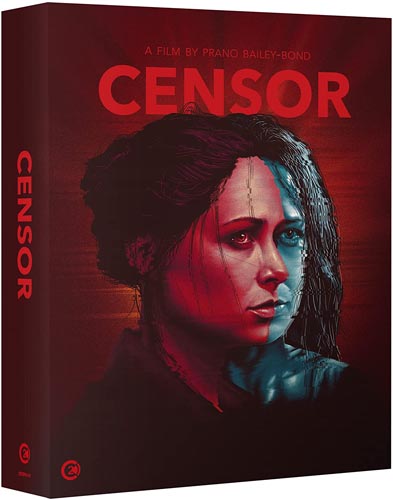
1985: Enid Blines is a censor working for the British Board of Film Classification. It’s a difficult time, with politicians having found that gory horror movies are a convenient scapegoat for society’s ills, leading to the press working people up into a frenzy so they support the banning of such films and imprisonment for anybody selling them. The very scissor-happy Enid believes that her removal of extreme material from videos is totally the right thing to do and is helping society, but she’s very troubled when a newspaper names her as the censor who passed a horror film that inspired a man to kill his family. Then, during a screening of a movie from notorious horror director Frederick North, Enid notices that events depicted parallel her memories of her sister Nina’s disappearance when they were both children. And when she watches another of his bloody exploitationers, the lead Alice Lee resembles Nina….

I was 14 when the Video Nasty crisis began in the UK, a thing which was so ludicrous that on one occasion an MP named Graham Bright claimed that extreme horror even affected dogs, while Apocalypse Now was removed from shelves for a while because of the slightly similarly titled Cannibal Apocalypse. I do remember it a little, though was slightly too young to really take it in and we didn’t even get a video player till just after the worst of it was over. And, while I was already a fan of the really old-school horrors that were frequently shown on TV, I didn’t fully get into the more modern stuff until two years later, and immediately became very frustrated because, despite all the cool movies I was discovering in video shops – usually ran and staffed by folk who didn’t seem to give a damn what my age was – many of the most exciting-seeming titles were either banned or heavily censored so that some of these incredible scenes and images described and even shown in the likes of ‘Fangoria’ magazine I was unable to see. Well, for a while. I didn’t experience any under the counter jobs but a certain magazine that had the two words ‘Video’ and ‘World’ in the title had loads of advertisements in the back pages with headings like ‘RARE UNCUT HORROR MOVIES FOR SALE’. Needless to say, I soon built up a pretty solid collection even though picture quality was often awful, but I didn’t care, just owning Cannibal Holocaust or I Spit On Your Grave was enough, though quality did improve and I even double dipped on some titles. Of course most of the entries on the Banned list were eventually re-released but were usually still cut, while if you were also a fan of martial arts movies you had to put up with equally tough censorship including a ban on nunchuku [chain sticks], thereby removing some of Bruce Lee’s best moments. For goodness sake, the video of Hollywood Chainsaw Hookers had to have the word ‘chainsaw’ represented by a picture of a chainsaw because the word was deemed unsuitable for people’s eyes.
Thank goodness then that this nonsense is largely a thing of the past, though the advent of political correctness has meant that film censorship of another kind is now growing, along with an increasingly Victorian puritanism from the likes of Netflix, who’ve recently been showing, for example, a version of the original Clash Of The Titans where two brief shots of boobs in a non-sexual context have been blurred over, even though it’s still fine to show the Medusa’s head being chopped off with blood oozing from the neck. Now some may say that one shouldn’t whinge about something like that because it’s so minor, but here’s the thing; my time as a young horror fan having to fund pornography [well that’s what an announcement on many videos claimed] in order to see widely acknowledged genre classics like The Exorcist or The Texas Chainsaw Massacre caused me to develop an absolute hatred of censorship, a hatred I still have. And said hatred meant that, for a while, I was finding it hard to like or even sympathise with the heroine of Censor, a rare horror film actually set within the world of censorship – I mean why haven’t there been others, for example a film about the director of a horror films who goes after the censors in order to chop them up just like they chopped up his films? Enid is introduced watching a movie with one of her fellow BBFC video “classifiers” and insisting on loads of cuts, while later on claiming that this is her mission and that it’s improving society. But due to Niamh Algar’s extremely sensitive and deep performance, and the fact that her character is deeply troubled, ,y hate soon dissipated got behind her after a while and really wanted her to succeed in her quest and survive to the end.
Censor, being basically two thirds one movie and one third another, doesn’t entirely hang together, a wry look at an insane time and environment eventually giving way to a depiction of madness and whether what we’re watching is actually happening. Parts of it seem reminiscent of Barberian Sound System and Saint Maud. It stops short of totally demonising the BBFC of the time [something that I would have done if I’d written the screenplay] but still adopts a point of view that most viewers ought to find to be a sane one. Enid clearly has major personal issues from the start and her happiness with the scissors could even be some kind of outlet. Said issues probably stem largely from grief, she being haunted by images of her sister Debbie whom her parents claim is dead but whom Enid still thinks has been kidnapped even after so many years. A coworker asks her how she seems unfazed by the violent content in the films they screen – Enid replies that, “you just need to focus on getting it right”. She seems to repress emotion and looks positively horrified when someone asks her out for a drink, though she certainly has reason to feel uneasy when a tabloid storm is created by a murder taking place that’s very much like one in [the real-life] Unhinged, which just her and one other censor were responsible for passing. We see the typical baying mob, though we also hear later on that the killer never even saw Unhinged, a possible reference to cases like the Jamie Bulger murder which caused Child’s Play 3 to be in the firing line for a while. What really startles Enid though is when she’s approached by Doug Smart, a film producer who claims that a veteran horror director named Frederick North has personally requested that she see one of his films. A few successive events lead her to believe that Debbie is an actress working for North, but what is North’s game and can we trust everything we see considering Enid is becoming increasingly – well – unhinged?
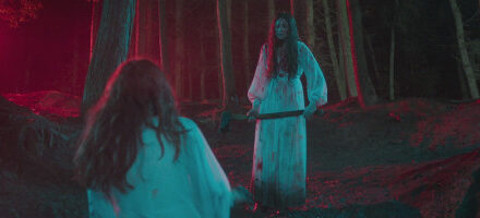
Things become almost surreal in the final third and the aspect ratio shrinks from the standard 2.35:1 widescreen format to a 1.33:1 full frame format, reflecting I guess Enid’s deteriorating state of mind. We don’t know entirely what is happening – or indeed if it’s happening at all. It’s fairly clear that the real world and the world of a film are mixing together, but at one point it seems like we’re even getting one fantasy on top of another. The BBFC’s main argument for banning movies was the suggestion that the public couldn’t distinguish pretend from reality, but ironically Enid seems to be the one who can’t make such a distinction. And then we get an ending which may reveal a surprise [or not] but which leaves several strands hanging. Though it was already available for home viewing, I still opted to see Censor in a cinema the first time round because my lounge is still no substitute in my view. I got the impression that the surprisingly full audience were really enjoying it until an hour in, after which there was still enjoyment but not as much, while a feeling of being just a bit [though not at all a lot] unsatisfied dominated as we left our seats. And that mirrors my own views, even though I often have no problem with films going weird and refusing to explain stuff. Perhaps one reason is that we end up with something that has seemingly been far more interested in context than content even though the latter seems to be promised. But I don’t want to be too critical, because I also wish to praise things like the direction of Prano Bailey-Bond. The music video look of some sequences means that one isn’t surprised to find out she cut her teeth on such things, but what the hell, I tend to like such a look in movies. Her experience means that she’s able to craft strong, almost poetic images [many of them featuring children], smooth montages and a good atmosphere. Oh, and there’s a terrific jump scare, sure proof that less is more when those are concerned.
There’s one graphic killing in ‘the real world’ which has a strange effect; it’s amusing, but we don’t particularly like ourselves for finding it to be that way because of the film we’re watching. Apart from a title sequence which shows clips from the likes of Driller Killer and Nightmares In A Damaged Brain [not to mention the even scarier Mary Whitehouse], Censor tends to hold back on showing the supposedly disgusting material that our heroic butchers are subjected to, though Bailey-Bond and her co-writer Anthony Fletcher put in fun little things to pick up on. The film initially being viewed is called Don’t Go Into The Church [“we soon won’t be able to go anywhere” says one to another], clearly a play on Don’t Go Into The House. It looks rather too stylishly photographed with lots of that blue and red that’s almost become a cliche even though not many filmmakers of the ’70s and ’80s actually employed it; even Dario Argento and Mario Bava only did sometimes. But we still enjoy the reference, and cinematographer Annika Summerson cleverly mingles this style with the deliberately drab look of the rest of the film while also providing some gorgeous compositions towards the end. The ‘Beast’ of one of North’s cinematic gems [and maybe two since he’s shooting a sequel] looks like George Eastman/Luigi Montefiore of The Anthropophagous Beast and Absurd. When Enid descends into an ugly underground station, we’re probably being asked to think of Isabelle Adjani and that scene in Possession – or is it just that our brains automatically make the connection? The bits in the BBFC office have a sitcom feel, cue some rather annoying boomer stand-up jokes about answering machines, archives clerks, call recognition not being a thing yet, etc, while the acting of some of Enid’s colleagues is a bit ropey. Thankfully we have the great and underappreciated Michael Smiley on great form as the sleazy, slimy Smart.
Some anachronism grates. I believe that there was the odd female censor, but I find it less likely that a black man would have worked for the BBFC, largely a clique of old middle class white men. Censor isn’t hard enough on them. For example it ignores, except for one line, the classism which caused them to be more lenient with arthouse fare because it was seen as the domain of the middle class who were apparently able to distinguish reality from fiction in a way the working class couldn’t, and were therefore less prone to being turned into psychopathic murderers or rapists by seeing strong material. There could have also been more discussion on the merits or not of these films, some of which are actually a bit crap. I expected more depth from Censor, yet it still comes off as a decent commentary, even a strange kind of tribute, to this bizarre period in film history in the UK, and it doesn’t keep screaming the ’80s either like most recent films set in that decade; this may have been dictated for budgetary reasons, but it’s rather refreshing not to have the sights and sounds of the era thrown at you, and the fact that we don’t get an exterior daytime scene until the end adds to the rather clammy atmosphere. And it gets what is perhaps its central point totally right. Enid is driven mad by movies, and we’re certainly asked to consider how a vulnerable mind can be affected by seeing chainsaws slicing people up or women being graphically raped. But that’s the thing; Enid clearly wasn’t ‘all there’ to begin with. She could have had a totally different job and still been driven into insanity. You can’t blame the films. As Peter Neal, a writer blamed for murders that copy ones that are carried out in his novels, says in Argento’s Tenebrae which made the Video Nasty list, “Let me ask you something? If someone is killed with a Smith & Wesson revolver, do you go and interview the president of Smith & Wesson?”
The above review was based on my cinema viewing of Censor. However, I was extremely keen to check out the copious amount of special features on Second Sight’s Blu-ray release, hoping especially to get some insight into the decisions made in the writing and filming of this flawed that still highly interesting film.
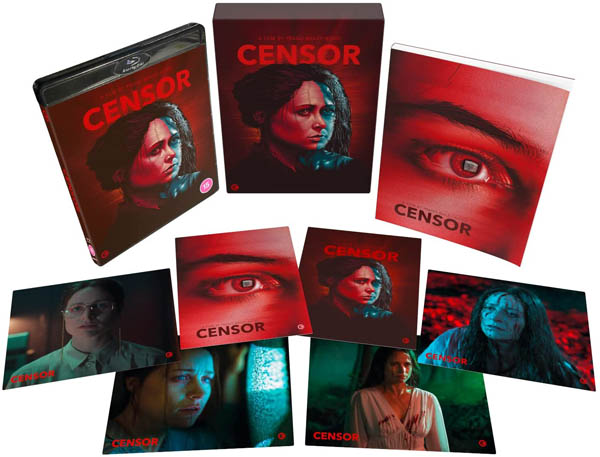
SPECIAL FEATURES
Audio Commentary by director and co-writer Prano Bailey-Bond and executive producer Kim Newman [2021]
The first of three tracks to listen to has Bailey-Bond being questioned by Newman who’s the executive producer of Censor. “You can ask all the difficult questions Kim”, she says, and he does probe her about all aspects, but she always gives good answers. She was first inspired to make the film by reading an article about how the BBFC would not allow blood on breasts to be shown because it apparently incited rapists. The two both go through their experiences of Video Nasties, Newman even having been involved in video distribution where people like Smart were often around and bribery often took place, and censors themselves; they both know one female censor who worked at the time. Apparently during that era they were part time and had other careers from which they were handpicked. It’s a constantly fascinating track, even though I wanted to know exactly why Bailey-Bond had the film become so different in its final third.
Audio Commentary by director and co-writer Prano Bailey-Bond, director of photography Annika Summerson, editor Mark Towns, and sound designer Tim Harrison [2021]
The second track is probably even better than the first. Granted, ones with four talkers tend to go well, but this one is just great, beginning with the information that the title sequence was put together by Towns because previews indicated that many people weren’t familiar with videos and the era, though personally I still don’t think that it was necessary. It’s revealed that a lot of editing went on, with much moving around of especially dream/fantasy moments and one whole journalist character cut out. It sounds like he might have added a bit. The sound of a boiling kettle being accidently heard over music gave Harrison the idea to then spend 45 minutes trying to record it properly so it could be used, Bailey-Bond considered showing Agar footage of animals being harmed to get the right reaction though ended up not needing to, and a piece from the Fist Of Fury score was wanted but was too expensive to use.
Audio Commentary by film historians Kat Ellinger, Lindasay Hallam, and Miranda Corcoran [2021]
And here’s the most scholarly track, though don’t worry; it doesn’t get particularly complex and things are explained very well so the ladies never lose us. After saying how the film blew them away, they really do point out and go into a hell of a lot of things, from the character of Enid who we’re told is virtually asexual and who constantly engages in subtle self abuse, to the idea that the classism that underpinned much censorship came from fear, to how it was assumed for a long time that only men enjoyed Video Nasty-type films and how they’re often cathartic and empowering for women, especially if they’ve undergone trauma. The possible interpretations of the plot and even what the ending might mean are also stated. Quite different from the other tracks, it nicely rounds off the trio which only suffers from not having input from Algar.
“Nasty” 2015 short film by Prano Bailey-Bond [15 mins]
So here it is; Bailey-Bond’s short film which, even though she’d made others, was no doubt her main calling cards in getting financing for Censor. It’s very much a precursor to it which employs the same kind of lighting in places, same deliberate distortion of the picture on the videos, and even uses some of the same footage at the beginning. Themes are so similar that this could be taking place in the same universe, as is plot structure, though The Evil Dead seems to be the main cinematic influence. It’s about a 12-ysar old boy named Doug whose father mysteriously disappeared in the woods nearby, the only possible clue being a Video Nasty in the player. Doug soon discovers that dear old dad had a secret collection of these things and soon gets into them himself, the most horrific scene being where mum destroys the tape he was watching. By contrast, the grisly ending is actually a happy one if you look at it in a certain way. Bailey-Bond already shows filmmaking dexterity in moments like when the camera moves from the lounge, past the kitchen and up the stairs before everything is black and we end up in the forest. Intriguing, chilling and a bit subversive.
“The Making of Censor” 2021 documentary [21 mins]
Some of the cast and crew provide insight and of course a lot of praise. Other ideas that inspired the film include “what makes us do something bad” and how we censor ourselves. Algar reveals that Smiley kept making her laugh with his improvisation, Bailey-Bond mentions Watership Down as the main inspiration for her censor’s den, and Fletcher says that writing Algar’s character was hard as she doesn’t have a friend to open up to. It’s a bit fluffy, but I think that’s to be expected really.
“My Nasty Memories” 2021 interview with filmmaker David Gregory [27 mins]
As a nice precursor to his documentary whose title is taken from a Daily Mail article, Gregory, who proudly shows off his complete Video Nasty collection, details his own experience of living through the Video Nasty nonsense, beginning with how video took off, one of the big reasons for it doing so being the wedding of Charles and Diana[!], then recalling with delight those early days of video shops where all genres were stacked together and all films were equal; in fact small films existed in greater quantities than big ones for a while because the major companies were afraid of piracy, though of course when the crisis came out they basically took over. He tells a great story of when his father caught him watching Zombie Creeping Flesh when it was banned, but realised how harmless it was after several minutes watching it.
“Ban the Sadist Videos” 2005 documentary by filmmaker David Gregory:
– Part 1 [50 mins]
– Part 2 [43 mins]
I’m not sure why this is presented in two parts when it didn’t need to be, but nonetheless this is a pretty terrific delve into the Video Nasty crisis, and one that lays much of the blame at the door of the media who seemed [make that “seem”, they still do it] to love stirring things up and who made the most spurious connections between real life incidents and movies that the perpetrators often didn’t even see. Video distributors, video shop owners, John Beyer of Media Watch UK, Peter Kruger who was in the Obscene Publications Unit at the time, film critic Derek Malcolmm and censors including the notorious James Ferman himself discuss the whole bizarre story, and you may come away liking Ferman slightly more, because in 2003, when the Jamie Bulger case caused a part two to start rearing its ugly head and another loony crusader triy to get passed a bill that would have virtually removed anything from video shelves that would not be right for children. It was Ferman who spoke and wrote passionately against it, and this surely was part of the reason that the bill never got through.
The lunacy of the whole thing can be summed by the fact that the question of adults being allowed to watch such material was rarely addressed; it was all about protecting the children, and skewed surveys and underhand tactics, not all of which can apparently be described, aided in this quest. Actually no, it can’t really be summed up because it was so insane. For example, there’s also the fact that none of the film’s directors, a few of whom we hear from, were involved. But then there’s also Malcolm recalling speaking in court when David Hamilton, the distributors of Nightmares In A Damaged Brain who was imprisoned for 18 months, was being tried. Malcolm said the film was, “not a classic, but well executed”, to which the judge replied, “so was the German invasion of Poland”. I’m not joking about that, by the way. And then there’s Mary Whitehouse defending her claim that she hadn’t even seen any Video Nasties with the peculiar and tasteless reply, “Does a doctor have to have cancer in order to detect it in a patient”. The piece is certainly one-sided even if two luminaries who were on the other side declined to participate. But I doubt that anyone who genuinely likes movies and cares about them, let alone horror movies, would today disagree with the idea that the whole affair was madness of a most ridiculous kind that caused far more harm than good. In fact did this lunacy, a lunacy which the government, the media, and even the church felt a need to happen, do any good at all?
DISC TWO
“My Own Nasty” 2021 interview with co-writer and director Prano Bailey-Bond [30 mins]
Disc Two’s special features begin with, of course, Bailey-Bond. Perhaps unsurprisingly, some of what she says can be heard on Disc One, but we’re told some more interesting things, such as the process of scripting with Fletcher; the two would have a sequence of scenes, then pick the ones they liked best and go away and right them. We also learn that the main character was originally male, and even when changed to a woman the auditions were huge because they hadn’t figured out her age.
“The Censor” 2021 interview with actress Niamh Algar [22 mins]
Though not heard in any of the commentary tracks, Algar gives good value here and in the ‘making of’. She tells of how she loved horror films as a teenager but now doesn’t, that the scenes with Enid’s parents were the hardest to get right, and that shooting with no days off had its advantage in that she couldn’t escape from her character.
“Penning a Nasty” 2021 interview with co-writer Anthony Fletcher [12 mins]
Fletcher tells us that he was never into horror but vividly remembers the period where so many people needed escape outlets, that they were countless drafts, and that working with financiers was a good experience despite what you might expect.
“Nasty Images” 2021 interview with director of photography Annika Summerson [18 mins]
The extremely talented Summerson lived with Bailey-Bond for a while so was privy to much of the evolution of Censor. She also mentions the two distinct looks, and how hard shooting in the forest in mud was.
“I’m Cutting It” 2021 interview with editor Mark Towns [13 mins]
Towns watched City Of The Living Dead at age 7 or 8 at a birthday party[!] which is what started him off. He also says that there were 12 cuts of this film, and that he’s most proud of the scene where Enid meets North even though he struggled to get it right.
“Nasty Sounds” 2021 interview with composer Emilie Levienaise-Farrouch [11 mins]
Levienaise-Farrouch, whose distorted voice provides much of the score, tells of how she first heard about the project because she was friends with the production designer. She also says how she wanted to go into a different direction from her earlier stuff, and mentions Watership Down just as Bailey-Bond did. Well, it’s quite a dark, scary movie, so it makes sense.
“Enid’s Gaze: Alexandra Heller-Nicholas on Censor” 2021 visual essay [21 mins]
Heller-Nicholas is always worth listening to. Here, her look at Censor takes its key from an important line of dialogue not even spolen by Enid; “People construct stories to cope, you’ll be surprised at what the human brain can edit out when it can’t handle the truth”. She also reminds us that, according to the press, Enid is complicit in the murders committed by the Amnesia Killer because she passed Unhinged, and also points out some important details about Enid’s glasses.
2021 Screening Q&A with Prano Bailey-Bond and Emilie Levienaise-Farrouch, hosted by Jed Shepherd [13 mins]
Most of this material can be heard elsewhere, but there’s a smattering of new information and this kind of extra is nice to see anyway. Bailey-Bond reveals that as a kid her two favourite films were The Lost Boys and The Evil Dead, and recalls of when she thought she’d upset Algar.
Prano Bailey-Bond in conversation with BBFC compliance Officer David Hyman from 2021 [40 mins]
Even though it begins with Hyman describing the Video Nasty crisis which we’ve already learnt about, this soon became one of the most interesting special features for me. As seen in the film, the censors did view films in twos and then debate with all the others if things were problematic, while Hyman also tells us a strange fact; that for some time, re-releases of successfully prosecuted films had to cut for subsequent releases even if they weren’t deemed too strong. In answer to Bailey-Bond’s question about modern audiences maybe becoming disensitised to violence, he points out that they’re also becoming sensitised to sexual violence. And then he explains why Censor got a ’15’ certificate despite showing clips from Video Nasties.
Deleted Scenes [2 mins]
The two scenes with the journalist Mike Shepherd are here, though nothing else; I’d imagine that would have been very hard seeing as so much footage was moved about anc cut into other footage.
LIMITED EDITION CONTENTS
English subtitles for the hearing impaired
Rigid slipcase with new artwork by James Neal
108 page soft cover book with new essays by Anna Bogutskaya, Kat Ellinger, Tim Murray, Alison Peirse and Hannah Strong plus production photos
6 collectors’ art cards
I still find that a few elements of this film don’t entirely work, but Bailey-Bond is undoubtedly a great talent with a strong voice and style. Second Sight’s release of one of the most fascinating and best looking offerings of 2021 is simply outstanding. Along with three audio commentaries we get around six hours of special features, recalling the DVD glory days. Highly Recommended.





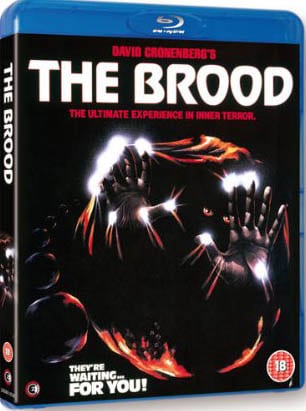
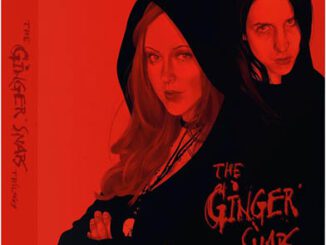
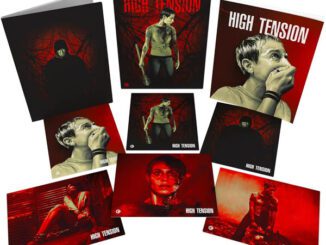
Aahh, the good old days of Mary Whitehouse and the moral crusades……..
When I say good, bloody crazy really……..